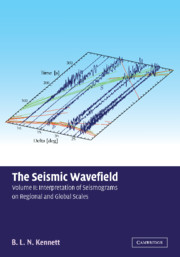Book contents
- Frontmatter
- Contents
- Preface to Volume II
- Part III Local and Regional Events
- Part IV Global Wave Propagation
- Part V The Three-dimensional Earth
- 30 The Influence of Heterogeneity
- 31 Imaging the Earth
- 32 3-D Global Structure
- 33 Mapping the Lithosphere and Upper Mantle
- Appendix Paths and Travel times
- Bibliography
- Index
32 - 3-D Global Structure
from Part V - The Three-dimensional Earth
Published online by Cambridge University Press: 31 August 2019
- Frontmatter
- Contents
- Preface to Volume II
- Part III Local and Regional Events
- Part IV Global Wave Propagation
- Part V The Three-dimensional Earth
- 30 The Influence of Heterogeneity
- 31 Imaging the Earth
- 32 3-D Global Structure
- 33 Mapping the Lithosphere and Upper Mantle
- Appendix Paths and Travel times
- Bibliography
- Index
Summary
Much of the impact made in recent years by seismic tomography has come from global studies in which three-dimensional structure has been revealed throughout themantle, and even in the inner core.
Two very different styles of approach have been employed, based both on the nature of the data sets which have been used and also on the style of representation of heterogeneity. For studies in which seismic waveforms are calculated using modal summation or dispersion is used, spherical harmonics are a natural choice for the basis of representation of heterogeneity because they are closely related to the mode representation itself. On the other hand for ray information, although it is possible to project rays onto a spherical harmonic basis there is not the same direct relation as in modal methods.
Where information from modal and body wave times is combined, then a single representation in terms of spherical harmonics is commonly adopted (see, e.g., Su & Dziewonski, 1997). However, studies using just travel times have frequently used cellular representations (e.g., Grand, 1994; van der Hilst et al., 1997), but spherical harmonics can be useful where summary properties are desired as in the work of Robertson & Woodhouse (1995, 1996) on the relationship of P and S wavespeed heterogeneity.
A very important aspect of global studies arises from the distribution of earthquake sources across the globe (figure 32.1). As is well known, the occurrence of earthquakes is concentrated into zones associated with subduction processes. There is a modest level of activity along the mid-ocean ridges and scattered, infrequent events in stable continental and oceanic regions. The distribution of high quality seismic stations is also uneven because they also tend to concentrate in areas of significant seismicity. The efforts of Geoscope and IRIS in establishing global networks of broad-band seismometers have made a major difference to coverage, but still such regions as Africa have a very limited number of stations. The other major gap is represented by the world's oceans and this has been partly infilled by island stations notably by IRIS and the Ocean Hemisphere Project. Ocean bottom geophysical observatories, either attached to disused telephone cables or free-standing are planned, but will be expensive to establish and maintain.
- Type
- Chapter
- Information
- The Seismic WavefieldVolume II: Interpretation of Seismograms on Regional and Global Scales, pp. 439 - 460Publisher: Cambridge University PressPrint publication year: 2002



